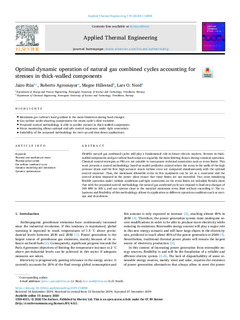| dc.contributor.author | Rúa, Jairo | |
| dc.contributor.author | Nord, Lars O. | |
| dc.contributor.author | Agromayor, Roberto | |
| dc.contributor.author | Hillestad, Magne | |
| dc.date.accessioned | 2020-02-18T09:44:35Z | |
| dc.date.available | 2020-02-18T09:44:35Z | |
| dc.date.created | 2020-02-17T11:18:38Z | |
| dc.date.issued | 2020 | |
| dc.identifier.issn | 1359-4311 | |
| dc.identifier.uri | http://hdl.handle.net/11250/2642183 | |
| dc.description.abstract | Flexible natural gas combined cycles will play a fundamental role in future electric markets.Stressesinthick-walled components and gasturbine load ramps are arguably the main limiting factors during transient operation.Classical control strategies as PID are not suitable to incorporate technical constraints such as stress limits.This work presents a control methodology based on model predictive control where the stress in the walls of the high pressured rum and the first high pressure steam turbine rotor are computed simultaneously with the optimal control sequence. Thus, the maximum allowable stress in this equipment can be set as a constraint and the control actions imposed in the power plant ensure that these limits are not exceeded. Two cases simulating flexible operation under realistic conditions and tight constraints on the stress limits are included. Results show that with the proposed control methodology the natural gas combined cycle can respond to load step changes of 165MWin300s, and can operate close to the material maximum stress limit without exceeding it. Thero-bustness and flexibility of this methodology allows its application to different operation conditions such as start-ups and shut-downs. | nb_NO |
| dc.language.iso | eng | nb_NO |
| dc.publisher | Elsevier | nb_NO |
| dc.rights | Navngivelse 4.0 Internasjonal | * |
| dc.rights.uri | http://creativecommons.org/licenses/by/4.0/deed.no | * |
| dc.title | Optimal dynamic operation of natural gas combined cycles accounting for stresses in thick-walled components | nb_NO |
| dc.type | Journal article | nb_NO |
| dc.type | Peer reviewed | nb_NO |
| dc.description.version | publishedVersion | nb_NO |
| dc.source.volume | 170 | nb_NO |
| dc.source.journal | Applied Thermal Engineering | nb_NO |
| dc.source.issue | C | nb_NO |
| dc.identifier.doi | https://doi.org/10.1016/j.applthermaleng.2019.114858 | |
| dc.identifier.cristin | 1794644 | |
| dc.description.localcode | https://doi.org/10.1016/j.applthermaleng.2019.114858 Available online 13 January 2020 © 2020 The Authors. Published by Elsevier Ltd. This is an open access article under the CC BY license (http://creativecommons.org/licenses/BY/4.0/). | nb_NO |
| cristin.unitcode | 194,64,25,0 | |
| cristin.unitcode | 194,66,30,0 | |
| cristin.unitname | Institutt for energi- og prosessteknikk | |
| cristin.unitname | Institutt for kjemisk prosessteknologi | |
| cristin.ispublished | true | |
| cristin.fulltext | original | |
| cristin.qualitycode | 1 | |

